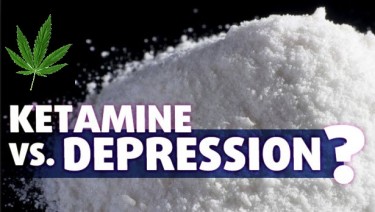
New Study of Ketamine in Depression Receives FDA Approval, But Not Medical Marijuana
There has always been a need for intensive clinical research into ketamine’s medical potential, but obtaining approval for such research has always been a problem. For this reason, the FDA’s recent approval of a study into the use of ketamine infusions for depressive disorders has caught the attention of many. It comes after a number of advocates reportedly called for an increase in the available clinical data on ketamine’s effectiveness in such conditions. Read on as we take a look at the gist of this new test and what its results could mean for sufferers of depressive disorder.
The FDA recently completed its review of Ehave Inc.’s EHVVF IND submission to evaluate the use of ketamine in patients with major depressive disorder (MDD). The company received full approval for the study, in which it will evaluate the clinical efficacy of a low-dose, weekly intravenous (IV) ketamine infusion in MDD. This comes after the FDA also approved a study on the use of ketamine to prevent organ transplant injuries. This shows that the FDA is taking a closer look at ketamine when it comes to approving clinical trials for a broader knowledge base.
The approved study is an open-label study that requires 35 designated participants. The selected participants had an inadequate response to two FDA-approved therapies for MDD. This also includes the current first-line therapy with antidepressants, which are used in sufficient doses and for an appropriate duration. According to Ehave’s CEO Ben Kaplan, this clinical trial will mark an important milestone in the history of the company’s clinical programs. It is also expected to be a breakthrough for patients dealing with MDD.
Kaplan recently reiterated the validity of this new study and why it has great potential. He notes that while ketamine has not yet been approved by the FDA for symptom relief in patients with MDD, it has significant potential. For this reason, an electroencephalography device will be used in the study to determine the activity of the brain during the administration of the infusion. The machine also detects the simultaneous brain responses to the administered infusion of ketamine. The addition of the EEG device further increases the complexity of the study and shows why it is receiving a lot of attention across borders.
The usefulness of the EEG device in this study was also confirmed by Dr. Confirmed Ali who is a board member at Ehave. He explains that using the machine to monitor brain changes is crucial to identify potential biomarkers that have not been exploited in the past. These biomarkers can then later be used to identify patients with MDD who may respond to prior treatment with ketamine infusion. This will lead to faster referrals to patients. It is also expected to reduce the level of trial and error usage as patients are treated.
Current FDA-approved treatments for depression include the use of selective serotonin reuptake inhibitors (SSRIs), serotonin norepinephrine reuptake inhibitors (SNRIs), monoamine oxidase inhibitors (MAOIs), and tricyclic antidepressants (TCAs). Psychotherapy has also been actively used as an approved treatment for depression, but all have proven ineffective in severe cases. The ineffectiveness of these current classes of drugs has led to the search for new drugs that may prove effective as antidepressants. This led to the repurposing of the anesthetic ketamine as an antidepressant and off-label analgesic and is the basis for the current investigation of ketamine’s potential in MDD.
The discovery of ketamine as a potential antidepressant was a breakthrough, particularly for patients with MDD. This has dismissed the demand for research on its effectiveness and level of activity. Clinical research conducted on ketamine demonstrated the disadvantages of administering ketamine intravenously. These symptoms include patient complaints, serious side effects, and an increased risk of diversion to the gray market. Racemic ketamine has traditionally always been used intravenously as an anesthetic in high doses, but its use as an antidepressant is effective at lower doses.
The benefit of low-dose IV ketamine administration in MDD has been actively demonstrated by Ehave. Initiating therapy at low doses creates scope for better dose control and allows for dose modulation appropriate to the patient. The use of intravenously administered ketamine also offers the advantage of reduced drug acquisition costs. This is certainly good news for patients dealing with MDD as it reduces the economic need for treating the condition.
Some outpatient clinics in the US already offer intravenous ketamine therapy for patients with MDD. These clinics have presented results showing the effectiveness of ketamine treatment for patients with MDD. It can therefore be assumed that the number of such clinics will increase after the conclusion of this study and the presentation of the results. When the effectiveness of ketamine in low doses is sufficiently established, the search for appropriate therapies for depressive disorders will start a new life.
It’s just one in a series of new therapies that companies like Ehave are asking the FDA to approve to facilitate research. Once approved, there is room for exploring the potential of these drugs and their effectiveness in various medical conditions. In the case of ketamine, conditions for intravenous administration and low-dose use apply. This can also be applied or modified to see its effectiveness in other conditions related to depressive disorders. One thing that is certain for now is that an increase in research will be beneficial for both patients and healthcare professionals, and that’s what we need right now.
KETAMINE AND DEPRESSION, READ MORE…

KETAMINE FOR DEPRESSION, WHAT DO WE KNOW NOW?

Post a comment: